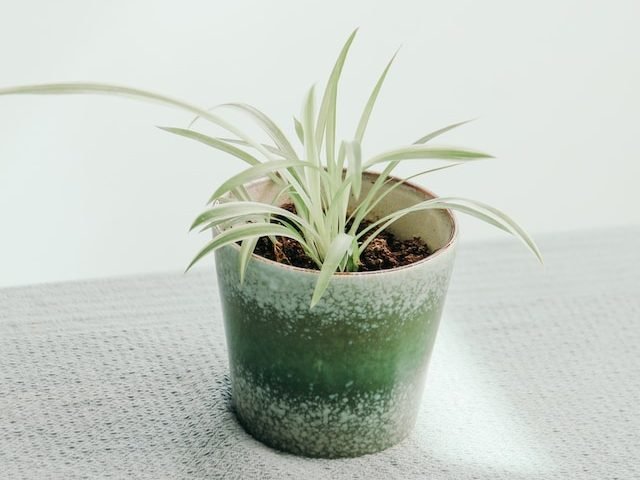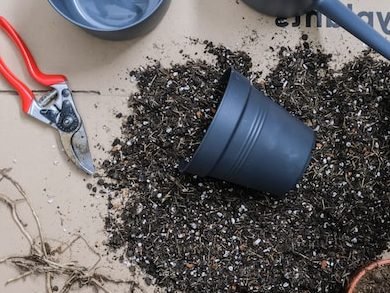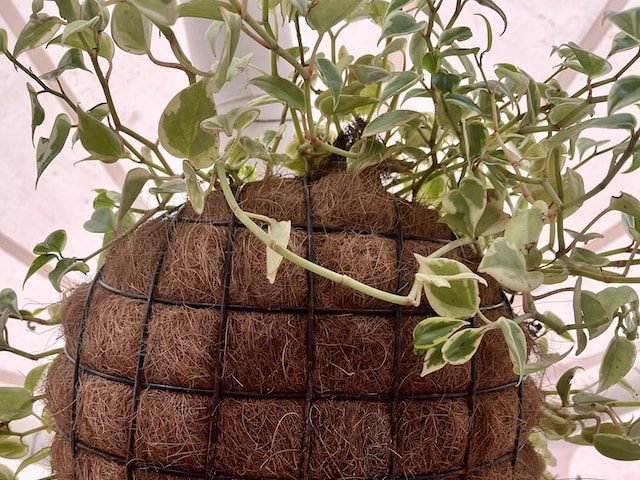Spider Plant in a Ceramic Pot

Whether you are a seasoned plant parent or just discovering your love for houseplants, it’s like you’ll already know that choosing the right type of pot for your houseplants is super important!
Ceramic pots not only lend aesthetic appeal to your interiors but also offer several benefits conducive to healthy houseplants.
Below we will discuss not only their key benefits but also touch upon how to choose the right pot size, the range of styles and types available, and much more.
We’ll go into preparing the pot for planting, necessary care instructions and common mistakes to steer clear of.
Contents
- Benefits of Using Ceramic Pots for Houseplants
- Disadvantages of Ceramic Pots for Houseplants
- Choosing the Right Size Ceramic Pot for Your Houseplant
- Different Types of Ceramic Pots
- Ceramic Pot Styles and Designs
- How to Properly Prepare a Ceramic Pot for Planting
- Tips for Transferring Houseplants to Ceramic Pots
- Caring for Houseplants in Ceramic Pots
- Common Mistakes to Avoid When Using Ceramic Pots
- Frequently Asked Questions about Ceramic Pots for Houseplants
Benefits of Using Ceramic Pots for Houseplants
First and foremost, ceramic pots are renowned for their excellent ability to hold moisture. Unlike terracotta pots, ceramics are less prone to drying out which means your plants stand a better chance of thriving, especially if they prefer moist soil.
Moreover, ceramic pots are heavier which makes them a great choice if you have taller or top-heavy plants. This reduces the risk of your precious greenery toppling over.
Also, their weight means they’re less likely to be knocked over by pets or children, and can withstand stronger winds if placed outside.
The thermal properties of ceramic pots are another important advantage to consider. These pots do a brilliant job at insulating the soil, protecting the roots from drastic temperature changes. This is particularly beneficial for houseplants that are sensitive to rapid fluctuations in temperature.
Lastly, the element of aesthetics can’t be ignored when it comes to ceramic pots. They’re available in a vast array of designs, colours, and sizes which means you’re also sure to find a style that goes with your home décor.
Disadvantages of Ceramic Pots for Houseplants
With all their advantages, ceramic pots are not without a few drawbacks that may impact your decision to use them for your precious houseplants.
Weight: Ceramic pots are significantly heavier than their plastic or fibreglass counterparts. This added weight can be problematic when you need to move matured plants or reposition your indoor greenery due to changes in light exposure or temperature. Although this can be a benefit as mentioned above, it’s also something for this list too!
Cost: As compared to other types of pots, ceramic pots can be a bit more on the pricey side. High-quality designs, in particular, can get rather expensive. If you’re on a budget or have a large number of plants, this may pose a problem.
Limited Drainage: Ceramic pots typically only have one drainage hole at the bottom or none at all. While this may suffice for some plants, for others it might limit proper water drainage causing potential overwatering problems, particularly in plants with high water sensitivity.
Thermal Conductivity: Thick ceramic walls can easily heat up when exposed to direct sunlight, increasing the pot’s temperature. As a result, the soil may dry out fairly quickly, posing a risk to the plant’s health.
Breakability: Ceramic pots, though sturdy, are fragile and prone to breaking. Accidental falls or hefty impacts can cause cracks or chips, potentially damaging the pot. This makes it crucial to handle ceramic pots with care.
Choosing the Right Size Ceramic Pot for Your Houseplant
Considering the Plant’s Root System
Every plant species differs in root development. Some have small, compact root systems, while some other varieties can quickly grow large, wide-reaching root systems.
Ever noticed a plant that became root-bound, with roots coming out of the top and bottom of the plant? That is a sign that the pot is too small.
And if the pot is too big then there are issues with watering too as the excess soil will stay wet for too long, leading to potential root rot.
- Small or Slow-Growing Plants: These typically require pots that are 1″- 2″ larger in diameter than the root system.
- Medium to Large or Fast-Growing Plants: They typically require pots that are 2″- 4″ larger in diameter than the root system.
Different Types of Ceramic Pots
- Glazed Ceramic Pots: These pots are very popular, thanks to their shiny, high-gloss finish which can range from smooth to textured. The glazing process renders these pots non-porous, preventing water seepage which is useful if you have houseplants that prefer a humid environment or need to retain moisture for extended periods.
- Unglazed Ceramic Pots: Contrarily, unglazed pots, often called terracotta pots, are porous and allow water and air to pass through their walls. This makes them a great choice for plants that prefer a dry, well-ventilated environment and could help prevent over-watering.
- Semi-glazed Ceramic Pots: As the name suggests, these ceramic pots are half glazed and half unglazed. They’re a great middle ground if you’re unsure about your plant’s water retention preferences. The glazed portion maintains moisture, while the unglazed part facilitates air flow and water evaporation.
- Self-Watering Ceramic Pots: These pots come with an in-built reservoir at the base designed to hold water. A wick draws water up from the reservoir to keep the soil moist over time, reducing the frequency of watering required. It’s a handy tool for those who are busy or frequently forget to water their plants.
Ceramic Pot Styles and Designs
Catering to both modern and traditional decors, ceramic pots can complement your home’s look or add a contrasting element for a pop of character.
Glazed – A common choice among houseplant enthusiasts, glazed ceramic pots are known for their shiny, smooth finish, that’s available in various colours and patterns. The finish not only adds an aesthetic appeal but also helps in moisture retention, benefiting your plants.
Terracotta – Coming from the Italian phrase, ‘baked earth’, Terracotta pots are made from a particular clay and are often unglazed. Typically brown-orange, they are a classic choice, adding a rustic charm to your decor.
Hand-painted – These ceramic pots are for you if you’re a fan of artistry and unique designs. Hand-painted pots feature a selection of creative and individualistic patterns and motifs, painted by skilled artisans.
Patterned – These ceramic pots incorporate everything from geometric shapes to intricate floral designs, offering a flamboyant touch to your interiors. These are perfect for adding visual interest, particularly if you want your plants to be key features in your decor.
How to Properly Prepare a Ceramic Pot for Planting
Step 1: Clean the Pot
Begin by cleaning the ceramic pot thoroughly with warm water and soap. Even if the pot is brand new, this step helps to remove any chemicals or dust that might be present. Simply, wash it thoroughly and allow it to dry completely.
Step 2: Prepare the Drainage System
Most ceramic pots come with one or more holes in the bottom. This is where the excess water will exit the pot to prevent overwatering. Place a few pieces of broken pottery or small stones over the holes to prevent soil from leaking out.
Step 3: Layer the Bottom with a Base Material
Put a layer of base material, like perlite or potting mix, in the pot. This aids in drainage and creates a lighter mix that promotes healthy roots.
Step 4: Put Your Plant in the Pot
Now, gently place your plant in the pot. Adjust its position until the top of its root ball is about 1 inch below the top of the pot. This leaves room for watering.
Step 5: Fill the Pot with Soil
Finally, fill the rest of the pot with soil. When adding the soil, press it lightly around the plant to remove any air pockets. Then, water your plant and add more soil if necessary.
Tips for Transferring Houseplants to Ceramic Pots
- Choosing the right time: It’s a good idea to transplant your houseplants in the morning as they have the rest of the day to recover, before temperatures fall at night.
- Watering the plant: A day before replanting, water your houseplant thoroughly. This reduces transplant shock and makes removing the plant from its current pot easier.
- Preparing the ceramic pot: Be sure to refer back to our section on how to prepare your ceramic pot properly. In a nutshell, you’ll need to clean it and add a layer of fresh potting soil.
- Handling the plant: When removing your plant from its current pot, handle it with care. Gently loosen the soil and tease the roots apart if they’re tightly bound.
- Planting: Plant the houseplant in the centre of the ceramic pot and fill in the space around it with more soil. Just be careful not to cover the stem or the base of the plant with soil.
- Aftercare: Water the plant after replanting and keep it in a shaded area for a few days to help it recover.
Caring for Houseplants in Ceramic Pots
Cleaning: It’s essential to keep your ceramic pots clean, which can be achieved by simply scrubbing with warm water and a soft brush. As you clean, watch out for the signs of mineral deposits or salt residues. These are signs of over-fertilization and can harm the health of your plants if not removed.
Check for cracks: While ceramic pots are known for their durability, it’s not uncommon for them to develop cracks or chips over time. Regularly inspect your pots for any signs of damage. If a pot becomes cracked, it may no longer retain water as efficiently, which could lead to your plants’ roots drying out.
Control sunlight exposure: Ceramic pots can get very hot in direct sunlight which can cook the plant roots, especially in dark-colored pots which absorb more heat. Make sure your ceramic pots aren’t placed in areas with harsh, direct sunlight all day. Morning sun exposure is acceptable and beneficial for most houseplants.
Proper watering: The porosity of some ceramic pots can make them dry out more quicker than others, especially in the exposure of sunlight and wind. Remember to water your plants accordingly, keeping in mind the specific water requirements of each plant species. Try not to over-water, as this can lead to root rot.
Regular re-potting: Most houseplants need to be re-potted every 12-18 months, and those in ceramic pots are no exception. This maintains the pot’s soil quality and gives the plant’s roots room to grow. The size of the pot should be approximately 2 inches larger in diameter than the old pot. Be gentle when you’re moving the plant to avoid causing root damage.
Common Mistakes to Avoid When Using Ceramic Pots
Ignoring Drainage Requirements: While ceramic pots often come with a single hole at the bottom for drainage, you might find some without any. If so, think twice before planting directly into them. Without proper drainage, your plant could suffer from root rot and other related issues.
Neglecting Balance: When choosing a plant for your ceramic pot, consider the balance of the pot and plant together. A top-heavy plant in a lightweight ceramic pot is a recipe for disaster. The pot might consistently tip over which can be dangerous for you or damage the plant/pot.
Disregarding Suitable Pot Size: Ceramic pots are denser and heavier than plastic pots, which can make larger ceramic pots difficult to move. Consider the full, mature size of your plant before deciding on a pot size. A pot that’s too large can result in water sitting in the extra soil, which can cause your plant’s roots to rot.
Overwatering: Ceramic pots are often glazed, inside and out, to make them waterproof. This looks great, but it also means that water doesn’t evaporate as quickly as it does in unglazed clay pots. Consequently, you should water less frequently and with less quantity than you might in other types of pots.
Forgetting to Clean the Pots: Ensuring your ceramic pots are clean is a crucial part of plant care. Dirty pots can house diseases, pests, and fungus. When you’re changing out the plants in your pots, give the pot a good scrub with soap and water.
Frequently Asked Questions about Ceramic Pots for Houseplants
Are ceramic pots good for houseplants?
Yes, some unglazed ceramic pots are excellent for houseplants because of their porous nature, which allows roots to breathe, preventing waterlogging and root rot.
All ceramic pots are also heavy, which offers stability for top-heavy plants. Not to mention, they are very aesthetic and come in a variety of designs to complement any decor.
Should I choose a glazed or unglazed ceramic pot?
Both glazed and unglazed pots have their merits. Glazed pots retain moisture better, which is beneficial for moisture-loving plants but may not be advantageous for succulents or plants that prefer dry soil.
On the other hand, unglazed pots absorb excess moisture, making them ideal for plants that don’t require high humidity around their roots.
Does the colour of a ceramic pot matter?
While the colour of a ceramic pot is often a personal preference, notably, it can affect how quickly the soil dries out. Darker coloured pots absorb more heat and can cause the soil to dry out faster than lighter coloured pots. Therefore, consider your plants’ water requirements and your local climate when choosing the pot colour.
Do ceramic pots need drainage holes?
Yes. Drainage is crucial for the health of houseplants. Most ceramic pots come with a drainage hole at the bottom to allow water to escape, preventing waterlogging.
If your pot doesn’t have one, consider drilling one yourself or use it as a cover pot and place your plant in a smaller, plastic pot with drainage holes within the ceramic one.















